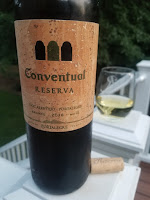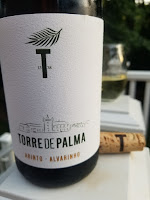Herdade do Esporão is a Portuguese wine brand that many readers might have familiarity with. They are the largest producer in the
Alentejo region and also the most widely distributed in the U.S.. We love receiving samples from this producer.
As a refresher, Alentejo covers much of Portugal’s southern half, spanning the flatlands below the Tejo River down to Portugal's southern Atlantic Coast. It accounts for 13% of Portugal's area under vine and 18% of wine production. Alentejo incorporates eight sub-viticultural zones (from north to south: Portalegre, Borba, Évora, Redondo, Reguengos, Granja-Amareleja, Vidigueira, & Moura). The climate is hot and dry with both a Continental and Mediterranean climate with winters exceptionally cold whereas spring and summer are dry and hot. The region experiences high levels of sunshine in the growing season -- over 3,000 hours annually. Wine-searcher.com also shares that the "Alentejo is broadly flat with hilly areas dotted across its zone. Major mountainous or hilly regions across the area include the Serra de São Mamede (1025m) on the border with Spain at the very northeastern end of the area, and the Serra de Portel (421m) and the Serra d’Ossa (649m), both in the central east".

The Herdade do Esporão estate is located in the
Reguengos de Monsaraz DOC sub-region which itself is located squarely in central Alentejo. The granite and schist soils and the local climate are particularly favorable to vine-growing and the region is well known for its production of high-quality wines with their own distinctive characteristics (
VisitPortugal). The region provides the estate with two key advantages: access to water and diversity of soils. According to the winery, "Alentejo is a dry region, averaging just 58 cm/23 inches of rainfall per year. The estate sits on a probable north–south fault zone; fault zones coincide with areas blessed with groundwater. This relative abundance of water was decisive to the medieval occupation of the land and building of the defensive Esporão tower.

Soil mapping begun in 2008 by geologist José Borrego established that at least seven different soils exist within the property, with dioritic soils (medium- to coarse-grained igneous rock) found only at the estate. Dioritic soils result in wines wines with lots of aroma, fruit, and acidity. Granite-origin granodiorite soils eventually yield wines with great freshness and minerality. Other soils include mottled schists (the Reserva Red) for grapes with high sugar and phenol levels, and two different versions of sandy clay loam soils are home to some of the white grapes".
The boundaries of the Herdade do Esporão estate were first established in 1267 and have been unaltered since. In 1973, José Roquette and Joaquim Bandeira bought the property because the Reguengos sub-region "ensures wines that were full-bodied but elegant and both big and seductive, thanks to a mix of very poor, stony soils and a harsh climate". The first wine was produced in 1985 using the brand name Esporão which coincidently was the Esporão Reserva Red -- which we will be reviewing the 26th vintage. Currently, they have 450 hectares of vines planted with 194 grape varieties, 37 of which are in full production. Three of these grapes are included in the Reserva White and five in the Reserva Red.
Esporão Reserva White 2022 ($23)
The grapes for this blend of Antão Vaz, Arinto, Roupeiro were grown on a granite/schist base with a loam/clay structure. After harvest, 75% of the grapes were fermented in stainless steel tanks and the remaining 25% in new American and French oak barrels. This slight oak treatment yields a creamy and structured core surrounded by a white floral and slightly citrus aroma and a fresh herbaceous finish.
Esporão Reserva Red 2021 ($23)
Red blends comprise a large percentage of Alentejo output and this wine is a blend of Alicante Bouschet, Touriga Nacional, Aragonez, Trincadeira, and Cabernet Sauvignon. Each variety was vinified separately, destemmed, crushed, temperature controlled alcoholic fermentation in stainless steel vats, concrete tanks and small marble lagares, pressed, followed by malolactic fermentation in stainless steel tanks. The wine then spent 12 months in new (20%) and old (80%) American and French oak barrels. After bottling, the wine aged at least 6 months in the bottle. This is one of my favorite Portuguese wines with dark fruit (blackberries, plums, and dark cherries), spice and herbs, and a wonderful structured balance with the approachable tannins and pop rocks acidity.
Notes on the Grapes:
Antão Vaz: This is the most dominate white grape in Alentejo and most prevalent in the Vidigueira and Reguengos sub-regions. The berries are loosely clustered and thick skinned providing disease resistance and they are also able to cope with drought-like conditions. In general it can provide stone and tropical fruit notes, various nuts, minerality, and ripe citrus.
Arinto: Alentejo's best white blending variety, thanks to its exuberant acidity. Discreet aroma. Green apple, lemon, and lime freshness and mineral notes. Arinto has large leaves for shading and super-high acidity, making it well suited to the hot Alentejo climate.
Roupeiro: A pale-skinned grape variety that is grown throughout Portugal under several aliases. Wines with Roupeiro exhibit citrus and stone fruit flavors with noticeable aromatic lift.
Alicante Bouschet: Although not indigenous to Portugal it has found a home accounting for 2% of all Portuguese plantings and ranking #8 for all reds. The grape thrives in Alentejo, particularly in Vidigueira and Reguengos, and is the second most planted red grape after Aragonez. It produced dense wines with dark fruit, pepper, smoke, and abundant tartness and astringency.
Touriga Nacional: A dark-skinned grape variety that is widely believed to produce the finest red wines of Portugal. Called Portugal's answer to France's Cabernet Sauvignon.
Aragonez: This is a southern Portuguese name for Tempranillo known to produce red wines with red fruit and leather aromas, high tannins, moderate to low acidity, and moderate alcohol.
Trincadeira: Considered one of the oldest varieties of Portugal. The wines produced from this grape grape are full-bodied and very rich as to their flavor. The aromas are fresh and herbaceous with flavors of blackberries and flowers.










































